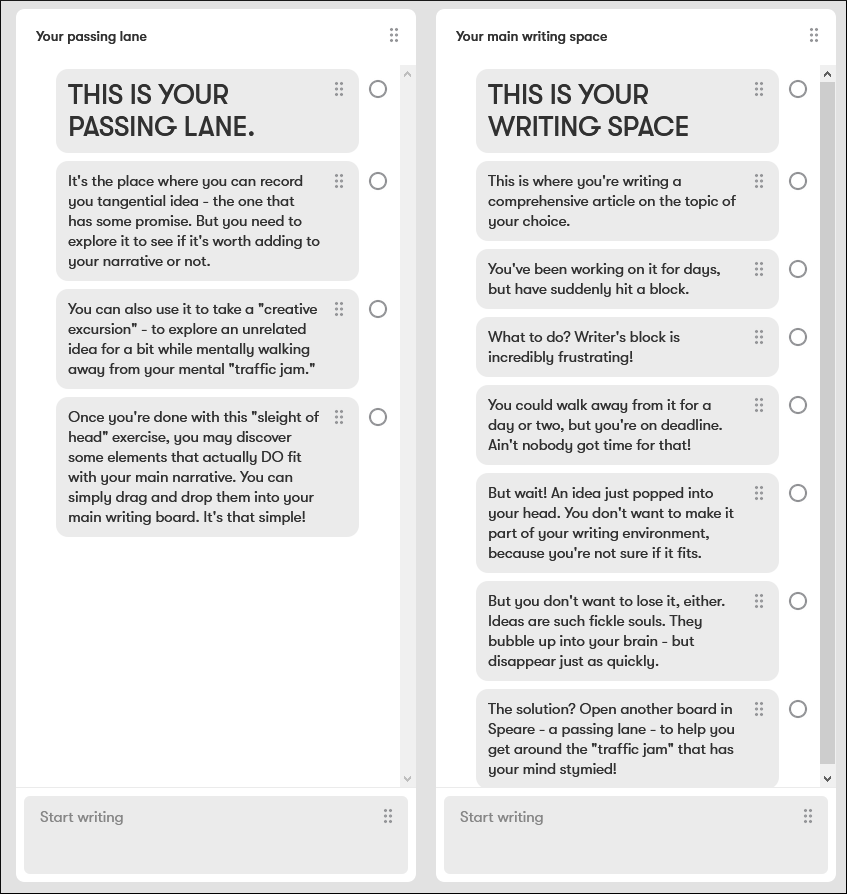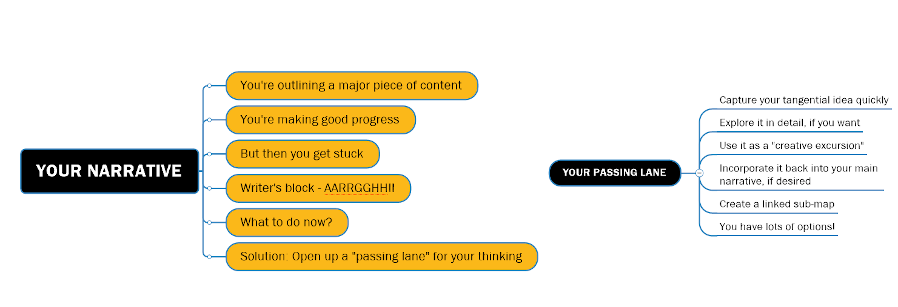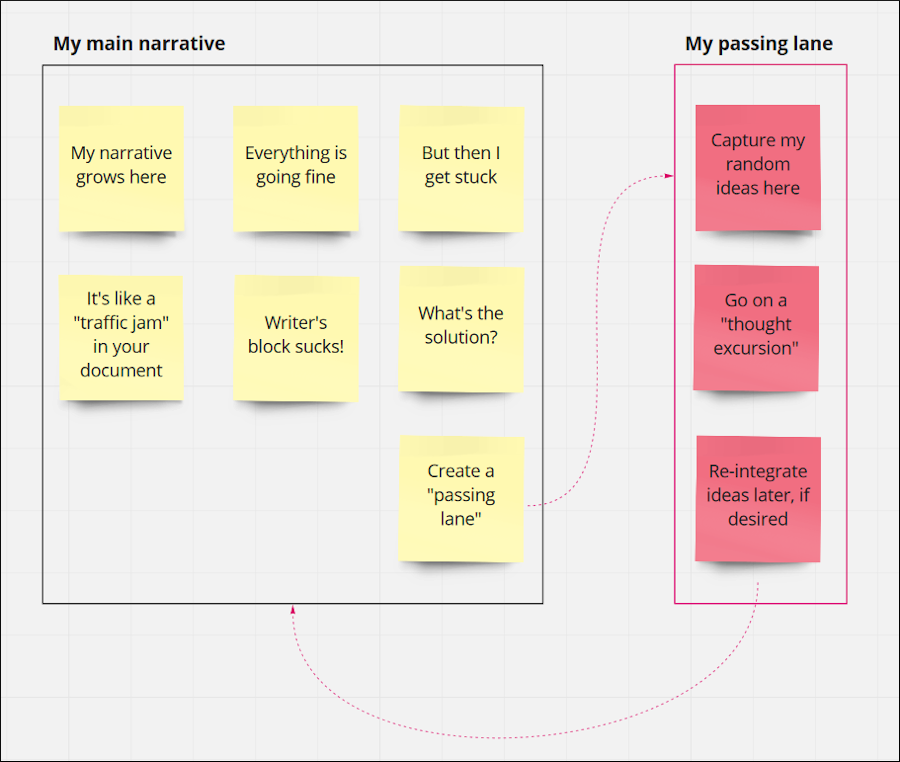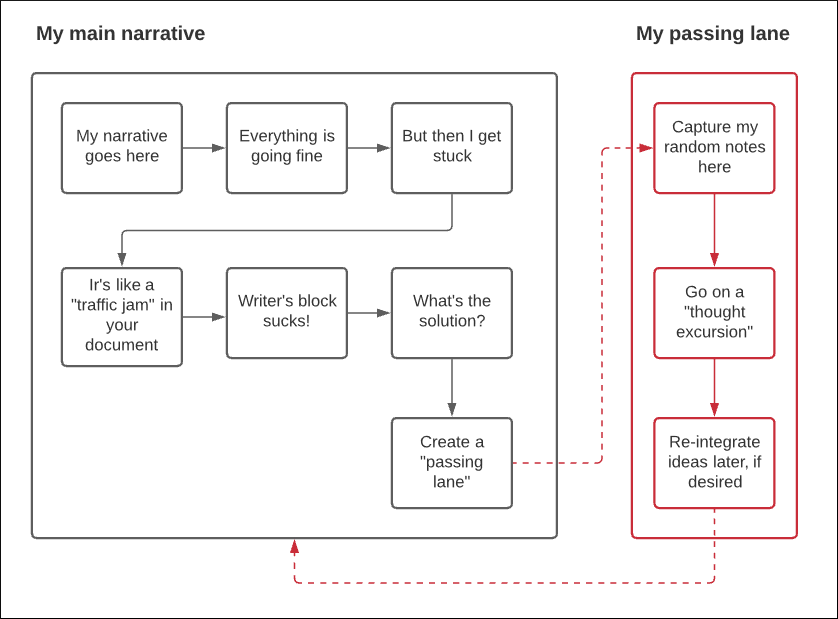
What do you do when you’re writing or brainstorming and your mind gets stuck? The dreaded phenomenon of writer’s block is like getting stuck in a traffic jam. You can’t move. You’ve got places to be and things to do. Your frustration level rises.
Imagine if a a passing lane opened up next to you. You’d be able to switch lanes and get back up to speed. Your stress would dissipate. All would be right with the world once again.
What if the tools you use enabled you to open up the mental equivalent of a passing lane to help you sidestep writer’s block and capture new lines of thinking – without losing momentum on your main project?
Kent Sisco, the developer of the innovative Speare writing tool, recently shared this fascinating analogy:
“Large writing projects can quickly become badly bottlenecked just like the cities with the worst daily traffic jams. That problem is part of the old “word processor” paradigm that gets clogged quickly without any space to maneuver as you write.
The new paradigm gives you the ability to open more boards for more ideas as you write, with the freedom to organize and merge it all together with a single click.
It’s like having the power to open up a passing lane in traffic. It literally accomplishes three things: 1) destroys writer’s block; 2) gets you focused again; and 3) helps you complete your writing project.”
I loved this idea so much that I had to explore it further, imagining what it could look like in a variety of visual thinking tools. Here’s how to employ this ideas in your own work, so you can employ a “passing lane” when you get mentally stuck.
How it works
A passing lane is useful in three scenarios:
- Sidestepping writers block,
- Capturing unrelated ideas while you’re deeply engaged in a project, and
- Taking a creative excursion – imagining an unrelated scenario or challenge, writing about it for a period of time, and then looking for ways to tie those thoughts and observations back into your main project.
A passing lane is like a digital scratchpad where we can capture new thoughts as they occur. It also provides a place where we can capture a new line of thinking when our original one becomes blocked.
Getting Things Done guru David Allen speaks of our “mental RAM” – our working memory, which can become crowded with a myriad of open tasks, goals and random thoughts. They inhibit our ability to focus on what we’re doing. Having a system to capture these thoughts helps to free up our mind so it can focus with zen-like clarity on the task at hand.
The problem with linear thinking tools
Linear thinking tools like Microsoft Word and Google Docs make it hard to accommodate this type of multi-threaded thinking. The unit of work is the document. In order to capture tangential thoughts or take a detour from our main writing project, we must open a new document, in a separate window.
In addition, these popular writing programs don’t treat ideas as discrete objects that can be easily rearranged, grouped, duplicated and manipulated. It can be done, but the structure of your ideas tends to be hidden within sentences and paragraphs.
How visual thinking tools are different
Visual thinking tools treat each element of an idea or writing project as an object that can be easily arranged or rearranged into different groupings or collections. This makes them ideal platforms for capturing, organizing and making sense of a large variety of information and ideas.
These qualities also enable visual thinking tools to open up a “passing lane” in our thinking, as needed.
Examples
How can you accommodate parallel or tangential lines of thinking – capturing them without losing them, without having them interfere with your main project?
Speare: The application that started this whole discussion of “passing lanes” handles this thinking scenario quite elegantly. Your ideas are arranged in blocks, which reside within boards. Boards can be focused on a single project or writing assignment. Got an unrelated idea that you want to capture? Simply open a new board, create a new block and capture it. You can develop it further in this parallel environment, and can always integrate it back into your writing later, if you want.

Mind mapping software: Create a floating topic as a “parking lot,” a place to table ideas for future consideration. They can be minimized so they don’t distract you from your main task at hand. But they’re still accessible in a single click and can easily be added to the main map at any time. Some programs enable you to easily create a new, linked sub-map to your main mind map. This gives you a shortcut.

Visual collaboration tools: Create a new boundary or region to contain your “passing lane” ideas. You can develop them separately and can always add them back into your main cluster of ideas, processes or data at any time.

Diagramming software: This type of tool gives you complete freedom to add “free-floating” ideas to your diagrams at any time.
What about you?
How do YOU handle writer’s block and the random ideas that pop into your head while you’re writing or working on an important project? Do you have your own version of the “passing lane” to accommodate them? it could be as simple as writing a Post-it note and sticking it to the bezel of your computer screen. Jotting a note in your journal. Or using your idea management or writing tool of choice to keep your thinking fluid and vital.
I look forward to your insights!


Leave a Reply